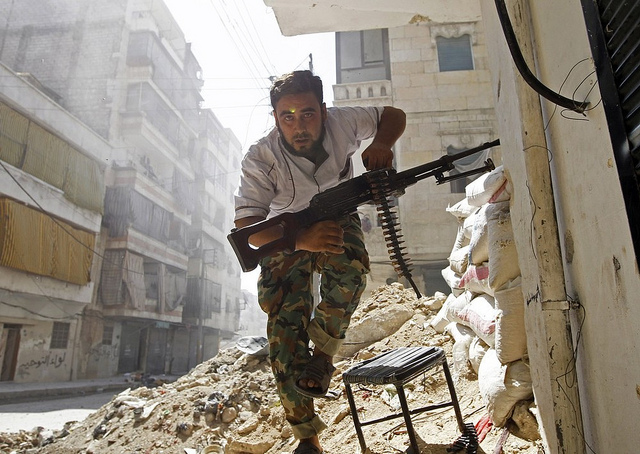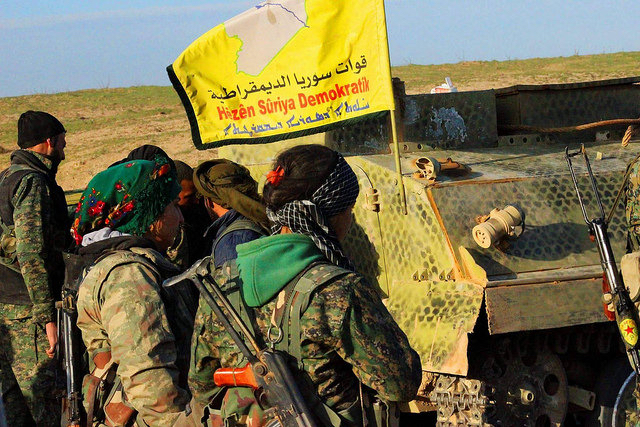This week marked the end of the sixth year of the war in Syria. On this terrible anniversary we examine the deepening economic, social and other divisions that make it so difficult for refugees to return to Aleppo, the city that has become a bellwether for the country’s future.
BEIRUT – In late January, a train to eastern Aleppo left the city’s main railway station for the first time in four years. The station, which was built before World War I as part of the Berlin-Baghdad network and is still referred to by some locals as “Gare de Baghdad”, has witnessed several conflicts in the course of almost a century, but none as devastating as the siege of Aleppo and the subsequent military offensive by the Syrian government in December.
As the train chugged through bombed-out eastern Aleppo as part of its daily route through the city, passengers peered through the windows at the wreckage in bewildered silence; their city had become unrecognizable. Some residents could be seen returning to their homes, clambering over the remnants of destroyed buildings, many of them without power, water and, in some cases, roofs and walls.
Syria entered its seventh year of conflict on Wednesday and many mourned the destruction of Aleppo. But bombed-out buildings are just one of the many obstacles to rebuilding the city. It has also suffered a significant loss of people, capital, intellectual capacity and diversity. Aleppo has in fact become emblematic of the prolonged sectarian, socioeconomic and rural/urban rifts across the country that could have a serious impact on the return of refugees and internally displaced persons (IDPs).
Despite centuries of multicultural existence, the last few years of war have fragmented Syria’s largest city, creating a pronounced division between the east and west, and reducing some 35,722 structures to rubble. Human rights groups have labelled Aleppo “the worst place in the world,” due in large part to the indiscriminate bombing of civilians and the government-imposed siege.
With much of Aleppo’s population denied basic services and their economic lifeline severed by fighting, many have fled to other parts of Syria and across its borders. Most recently, 37,500 people were led out of the city in December in a mass evacuation brokered by Turkey and Russia during the so-called “liberation” of the eastern side of the city. By early January, the United Nations reported, only about 2,200 families had returned. Aleppo has undergone ostensibly permanent demographic changes, according to several organizations, including the U.N. refugee agency.
“Reversing such a drain of people and resources will require a very large investment, if we want to get back to the pre-conflict situation,” researchers at the National Agenda for the Future of Syria (NAFS) told a conference in Beirut last November. Launched by the the U.N.’s Economic and Social Commission for Western Asia (ESCWA), the program is mapping out the social, political and economic factors shaping any future reconstruction.
Bassel Kaghadou, lead consultant at the NAFS project, notes that there is now heavy “identity polarization” stoked by the warring parties and their proxies. The “identities and micro-identities” of different cities that have hardened over the conflict years should be taken into account by the U.N.’s political and humanitarian branches, says Kaghadou.
“The conflict in the Damascus area, for example, has more of a financial and a rural/urban dimension, whereas in areas like Homs it’s more of a sectarian dimension. In areas like Aleppo, it’s more of a poor/rich divide – those who have, those who don’t have.”
Understanding the nature of conflicts in the different urban centres is vital for assessing the feasibility and nature of returns, Kaghadou adds.
Disappearing Diversity
Aleppo has set an alarming precedent for dozens of other places under siege across the country, according to internal U.N. reports and local observer groups – and the city may be a bellwether for other returnees and the rebuilding of not only infrastructure but also the social fabric. Government forces recently encircled three rebel-held neighborhoods in eastern Damascus in order to secure Eastern Ghouta, an agricultural area home to an estimated 250,000 civilians, which may be the next instance of mass displacement.
“Few places are as ancient and diverse,” writes Philip Mansel in his book “Aleppo: The Rise and Fall of Syria’s Great Merchant City,” which was published last summer before the government offensive in late December. This followed an on-and-off siege by opposing sides that had been in effect since 2012.
Mansel’s exploration of one of the world’s oldest continually inhabited cities – part of a lifeline linking Mesopotamia to the Mediterranean and a key port on the Silk Road – is even more striking today. The Assyrians, Persians, Greeks, Romans, Arabs, Ottomans and French who at various times competed for control of this venerable merchant city – which Mansel describes as an artery pumping economic gain and cultural exchange between the Far East and the West – would not recognize it. Today’s Aleppo epitomizes the impact of sustained violence.
Speaking to News Deeply, Mansel expresses his concern that the near-demise of centuries of multicultural coexistence in Aleppo is a worrying sign for the future of mixed communities in Syria.
The difficulty of assessing demographic change, especially as a result of a lack of verifiable data, means the situation on the ground is changing nearly every week, Mansel says.
“A lot of minorities are also leaving Aleppo and they are often well-connected. Armenians are going to independent Armenia and Christians have been leaving even before the conflict. Although many Sunni Muslims are leaving, many also cannot leave.”
The Russian-led “scorched earth” campaign – akin to the Battle of Grozny in Chechnya– emptied swathes of the city of its residents, making it easier for government forces to take over. During the latest Syrian peace talks in Geneva, U.N. human rights investigators accused all sides of war crimes in Aleppo. They also concluded that the mass evacuations of the rebel-held enclave in eastern Aleppo amounted to “forced displacement.” French philosopher Bernard-Henri Lévy has gone so far as to call Aleppo one of history’s costliest lessons in “urbicide,” with returns of refugees and IDPs a challenge for the foreseeable future.
Establishing a concrete process to ensure long-term civilian returns is more pressing than ever, particularly as safe zones become a less viable option and neighboring countries, such as Turkey, Jordan and Lebanon, seal their borders.
“There are no safe zones. When you take a civilian from eastern Aleppo or eastern parts of Aleppo out to Idlib, there are still threats of brutal government airstrikes and the armed opposition, which is also abusive and repressive,” Syrian-Canadian writer and independent analyst Yazan al-Saadi told News Deeply.
Complex Divides, Difficult Returns
In the light of rapidly changing demographic realities in Syrian cities, media outlets have voiced concerns that a majority of the refugees and IDPs, who are Sunni Muslims, might not be able to return to their homes. This is particularly true in Aleppo, where the western side is currently dominated by minorities – Alawites, Christians, Armenians, Druze – and the eastern neighborhoods are mainly Sunni.
“One has to be very careful when making such claims,” said al-Saadi, adding that the Syrian government is unlikely to assess civilian returns based on a “black and white” assessment of sectarian identity. “It is not a case of ‘you are Sunni, so you cannot come back.’ It is about whether you are with ‘us’ [the Syrian regime] or not.”
Mansel says the divisions of identity among the people of Aleppo, especially over the conflict years, go beyond religious affiliations. The city “has been drawn into wars between Sunni and Shiite; Salafis and other Muslims; secularists and clericalists; dictators and liberals; armies and civilians; the city and the country.”
The rural/urban identities added yet another dimension to the divides, whereby a vast majority of the “bourgeoisie in the city were afraid of this uprising, and perceived it as coming from rural areas and seeking more social justice,” said Joseph Daher, a Swiss-Syrian academic, originally from Aleppo, speaking from Geneva.
Daher and al-Saadi point to “class divisions” as the most important dynamics in Aleppo’s case.
These entangled strands of identity have prevented the return of most civilians who fled the city. At the same time observers caution that the siege of Aleppo and the ensuing relocation of residents is part of a concerted strategy to orchestrate long-term changes of identity and social make-up across the country.
Control of the key urban centers along the spine of Syria has been a goal for all warring sides. The government takeover of Aleppo, and the “crushing of opposition presence in the city was crucial for the regime ahead of new negotiations [that took place in January in Astana and February in Geneva],” Daher added.
The so-called liberation of Aleppo was a major turning point in entrenching the Syrian government’s hold on the spine of the country. Politically and physically controlling these cities is key for the regime to regain control of the entire country. With Idlib – still under rebel control – being a key vertebra of this spine, many fear the evacuees from Aleppo who have been sent to IDP camps in the northwestern province have essentially gone from one siege to another. The mass evacuations from eastern parts of Aleppo have also brought the competing and oft-conflicting notions of safe passage versus depopulation to the fore.
Evacuation or Forced Displacement?
Months before the Aleppo offensive, the U.N. emergency relief coordinator Stephen O’Brien explicitly called mass evacuations and prolonged sieges violations of international humanitarian law. “All sieges, a medieval tactic, must be lifted,” he said. “This should not [occur] through any type of agreement which results in the forced displacement of the civilian population.”
While depopulation to create demographic changes is indeed a flagrant violation of international law, ascertaining the voluntary nature of civilian evacuations amid conflict is a difficult process. Most humanitarian workers insist that it is equally dangerous to delay evacuations when the basic lifelines for food, shelter and medicine are severed with no guarantees of safety.
When civilians and opposition fighters boarded buses in Aleppo heading toward Idlib, the U.N. stated that while evacuations were not within their remit, they were ready to assist anyone “voluntarily” leaving the city. The absence of impartial monitors on the ground to document instances of forced relocation points to a glaring gap in civilian protection. Given that at least half of the Syrian population fled their homes over the past six years, population transfer of native residents, with no guarantees of return, remains a gray zone.
“The U.N. is inherently biased because of the way it is set up [where it has to engage with states]. INGOs are also obliged to deal with international laws and humanitarianism that at times clash with the needs of a society,” al-Saadi said. “The only solution that is I see is an international organization or international body of civilians.”
Those dealing with returns must also be mindful that depopulation is not necessarily a concern for the Syrian government, given that the country experienced a significant growth spurt in the 1960s, al-Saadi added.
The Economics of Returns
In Aleppo’s case, socioeconomic divides appear to play as influential a role as the sectarian make-up. One has to look at the “social geography” of the fighting in the city, visible as early as the summer of 2012, to understand the possibilities of returns, claim Jean Claude David and Thierry Boissière, authors of “Alep et ses territoires,” which explores the relationship between urban spaces and the societies of Aleppo.
The authors point out that journalists and observers seeking explanations through geopolitics sometimes overlook localized conflicts and the intertwined social and economic tensions that inflame hostilities, as in the case of Syria’s urban centers.
“The organization of [public] space into two large socioeconomic groups is still blatant nowadays between a rich West quarter [of the Medina] and the more popular three-quarters, North, East, and South, with the economic classes traversing confessional and religious identities,” according to the authors. But the blockade of trade in the city and decreased interactions between the different quarters during the conflict has further alienated the two sides.
Across the country, extreme class divisions and the rural/urban flight due to loss of livelihoods are at the root of the eruption of conflict, says Abdullatif El Ali, a Syrian researcher completing his international relations degree in Turkey. The class divide gradually “transformed into an identity divide,” he adds.
Ali, who is from Al-Muslimiyah in the governorate of Aleppo, cites his own family’s experience. In an interview with News Deeply he recalled how his uncles, who were farmers, struggled to make a living in the village before the uprisings started. A significant percentage of working-age men moved to urban centers. Aleppo was the closest economic hub for many.
Alongside the “pro-government” or “anti-government” divide is the issue of the indispensability of returnees to the future economic growth of Syria, said al-Saadi. The instrumentalization of people as “tools rather than multi-dimensional individuals” will dictate the Syrian government policies with returns, he added.
Syria’s GDP has dropped 40 percent since the start of the conflict, meaning that “attracting capital back into the country will go hand-in-hand with reversing brain drain” and ensuring a safety net for returnees, according to the NAFS program.
The Need For a Refugee Policy
Discussion of the feasibility of returns for Syrians of differing economic, social and sectarian identities begs a fundamental question: What is the Syrian government’s refugee policy? The simple answer, according to all the researchers News Deeply interviewed, is that there is none.
“If we were to take the government’s statements that everyone is free to return at face value, what guarantees is the government willing to provide, not just with safe passage but also with social protection, economic stability and access to their homes?” asked al-Saadi.
El Ali points to what he calls “accumulating evidence of dispelled people’s homes [that were] looted, ruined and became [the] property of the state.”
For civilians to return in significant numbers, it appears that the reconciliation process must address the social, economic and religious-sectarian divides that have left a significant footprint on Syria’s communal balance and identity. Failing to do this risks turning Syria’s cities into versions of Sarajevo, where, decades after the armed occupation, ethnic divisions continue to challenge the return of native residents, says Galen Lamphere-Englund at the Aleppo Project.
A concrete “returns” policy, which has yet to be explicitly addressed in international negotiations, is a pivotal issue that will determine the futures of millions of displaced Syrians. However, according to Kaghadou, “peacebuilding [in Syria] will require forging a new social contract,” without which many refugees will not return.
This article originally appeared on Syria Deeply, and you can find the original here. For important news about the war in Syria, you can sign up to the Syria Deeply email list. Photograph courtesy of a.anis. Published under a Creative Commons license.





